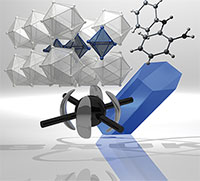
This complicates the space-group determination and structure solution.

Therefore, the intensities of reflection h 1 k 1 l 1 of domain 1 and the twin-related reflection h 2 k 2 l 2 of domain 2 sum up to a single observed intensity.

For merohedral and pseudo-merohedral twins the reciprocal lattices of the different domains overlap (nearly) exactly. Twins can be classified depending on the twin law (Herbst-Irmer, 2016 ▸ Herbst-Irmer & Sheldrick, 1998 ▸ Parsons, 2003 ▸ Yeates, 1997 ▸ Dauter, 2003 ▸ Banumathi et al., 2004 ▸ Luo & Dauter, 2016 ▸). In reciprocal space, the twin law describes the symmetry operator that transforms the h 1 k 1 l 1 indices of one domain into the indices h 2 k 2 l 2 of a second domain. Therefore, twins may be defined by a symmetry operator that transforms one orientation into another, the so-called twin law, and by the fractional contribution k i of each component. Twins are defined as regular aggregates consisting of individual crystals of the same species joined together in some definite mutual orientation (Giacovazzo, 2002 ▸). The structures were solved by experimental phasing using SHELXT for the first two structures and SHELXC/ D/ E for the two protein structures all models were refined with SHELXL. TWINABS was used for scaling, empirical absorption corrections and the generation of two different data files, one with detwinned data for structure solution and refinement and a second one for (usually more accurate) structure refinement against total integrated intensities. The data were then integrated with SAINT. The unit-cell constants and the orientation matrices were determined by the program CELL_NOW.

In this article, the successful solution and refinement of one mineral, one organometallic and two protein non-merohedral twins using a common strategy are described. However, with hindsight it is possible to detwin the data because there are reflections that are not affected by the twinning. This complicates the unit-cell determination, indexing, data integration and scaling of X-ray diffraction data. This leads to three kinds of reflections: reflections with no overlap, reflections with an exact overlap and reflections with a partial overlap of a reflection from a second domain. In contrast to twinning by merohedry, the reciprocal lattices of the different domains of non-merohedral twins do not overlap exactly.


 0 kommentar(er)
0 kommentar(er)
